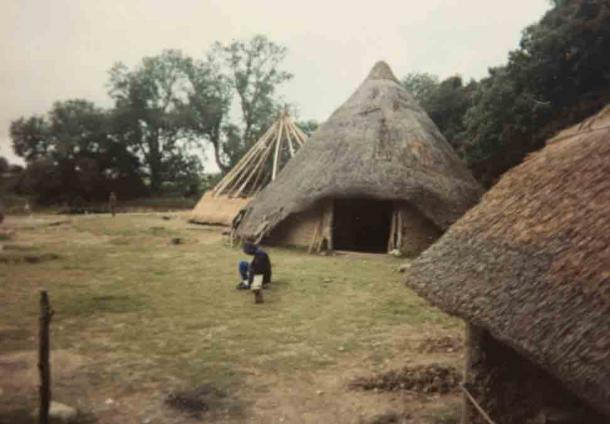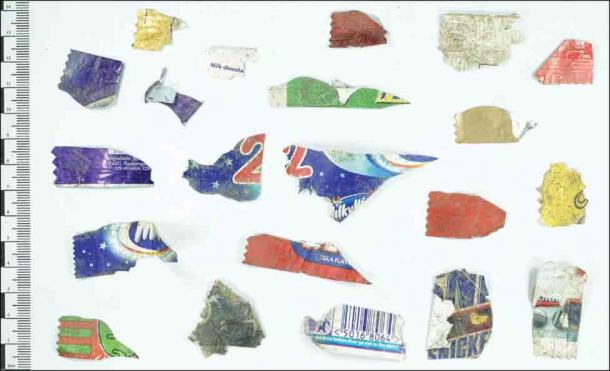The Plastic Age is a term some scholars suggest we use to refer to the modern, plastic dominated times in which we live. Plastic usage and littering is also linked to the Anthropocene – the unofficial, current geological epoch marked by the impact humans have on the Earth’s geology and ecosystem. Regardless of one’s perspective on these terms, no one would argue that plastic is not a popular material these days. A recent study in Wales also demonstrates how plastic can impose itself on the archaeological record, and predicts the archaeology of the future.

Top Image: ‘Wintry Day: Castell Henllys.’ Plastic Age artifacts were found at the site of the dismantled roundhouses. Source: Dylan Moore/ CC BY-SA 2.0
Where the Iron Age Meets the Plastic Age
The new study published in the journal Antiquity explains that Castell Henllys is a well-excavated hillfort in Wales which dates back to the late first millennium BC, in the Iron Age. In the 1980s, two experimental reconstructions of Iron Age roundhouses were built at the site. They were built on top of the locations of real Iron Age roundhouses and their construction was based on archaeological evidence recovered from the site.

Castell Henllys. A view showing the entrance to one of the completed round houses in 1988. (Malcolm Neal/ CC BY-SA 2.0 )
The roundhouses have been key features of the heritage site, but health and safety concerns ordered that they could not simply be refurbished after 30 years, the roundhouse replicas had to be dismantled and rebuilt. In 2017/2018, the Pembrokeshire Coast National Park called in researchers to excavate the dismantled roundhouses. Originally, the archaeologists were interested in investigating the remains of the reconstructed Iron Age roundhouses to find out more about the decay process, how it impacts archaeological preservation, and which activities leave their mark on the archaeological record.
The researchers write that their study of the roundhouse replicas accomplished that goal and has “as expected, illuminated decay processes and demonstrated how archaeological signatures of reconstructed buildings can help in the interpretation of later prehistoric structural remains.” They also expected that they would find artifacts and other signs of the 30-plus years of the roundhouses hosting visitors, school trips, and even a reality TV show (called ‘Surviving the Iron Age’ ). But they didn’t expect to find so many signs of the Plastic Age at Castell Henllys. The sheer number of plastics and plasticized items such as candy wrappers is the bigger discovery.

Examples of the small fragments of sweet wrappers recovered from the Earthwatch roundhouse at Castell Henllys. (A. Fairley Antiquity/ Antiquity Publications Ltd )
The Hidden Life of a Popular Heritage Site
To set the scene, the researchers write that this was “a well-maintained heritage site, from which modern refuse is systematically cleared away to retain the illusion for visitors of an Iron Age environment.” So, the researchers were shocked to discover over 2,000 plastic items during excavations, a number which “far outweighs the replica prehistoric items used at the site or even other traces of modern life,” according to an Antiquity press release.
Professor Harold Mytum from the University of Liverpool and the lead author of the new study, said, “We had not anticipated the large amounts of rubbish – mainly plastic – that was deposited, even though the houses did not look untidy.” Professor Mytum co-wrote the article with James Meek of the Dyfed Archaeological Trust.

Excavations at the site reveal recent relics of the Plastic Age. (H. Mytum/ Antiquity Publications Ltd )
The roundhouses were called the ‘Cookhouse,’ which was set up like an Iron Age roundhouse, and ‘Earthwatch,’ which was used more like a classroom and had benches inside it. The Cookhouse gave visitors an insight into Iron Age life and taught them about domestic life as well as cooking and weaving techniques from that time.
In the Antiquity paper by Mytum and Meek, the Cookhouse is described as “the most frequently visited roundhouse at the site,” however the researchers found that “relatively little debris accumulated within it, as the public would enter for a brief inspection of the interior, or circulate around by the inner ring of posts, and perhaps sit round the hearth and absorb the atmosphere, rather than participating in any activities that could easily generate refuse to be discarded.” Overall, the researchers found 422 modern materials (which also included non-plastic items such as nails, coins, and tools), during their excavations at the cookhouse.

The two Iron Age replica roundhouses where signs of the Plastic Age were found. (H. Mytum/ Antiquity Publications Ltd )
But the Earthwatch excavations revealed a much larger impact of the Plastic Age. 2759 modern objects were found at this location, mostly consisting of plastics and plasticized items. Many of the materials were linked to the frequent usage of Earthwatch as a place for students to eat their lunches while they were on field trips to the heritage site. Candy wrappers, straw wrappers, and other food-related items such as plastic spoons and forks made up a large portion of the plastic assemblage.

Plastic Age artifacts? Plastic items associated with the consumption of packed lunches in the Earthwatch roundhouse. (A. Fairley/ Antiquity Publications Ltd )
A lot of the plastic found in the dimly-lit roundhouses was fragmentary, which the researchers say, “may explain why so much plastic was found, despite efforts to keep the site clean. These small fragments may be easier to tread into the ground or go missing in dark corners.”
Two More Scholars Warning about the Plastic Age
This research reveals that while cleaning an archaeological or heritage site that is frequented by visitors can keep it looking good, it cannot fully remove the impact of who has been there. The study also makes you wonder what future archaeologists could make of the discovery of a pile of candy wrappers at a heritage site.

A Godzilla-themed thermos wrapper was found in the Earthwatch roundhouse. (A. Fairley/ Antiquity Publications Ltd )What would a future archaeologist make of this discovery?
Regardless, it suggests cleaning alone is insufficient to prevent signs of the Plastic Age; a fact the researchers hope to use with these findings to raise environmental awareness and reduce the amount of plastic entering the landscape.
As for Mytum and Meek, this research at Castell Henllys has inspired them to join with other scholars who assert that we are living in the Plastic Age . Professor Mytum also notes that “Plastic spoons, straws, snack bar wrappers and cling film, and even labels from apples, were all very common finds,” so Mytum says that “Schools and families need to think about how they can make pack lunches that are more environmentally friendly .”
In the conclusion of their paper, the researchers express their hope that the Plastic Age won’t last as long as the Iron Age did. “With many initiatives now pushing to switch from disposable plastic and plasticised items, this may be a narrow, but archaeologically distinctive chronological horizon,” the researchers write.
Pembrokeshire Coast National Park has decided to use the results of the recent study in an educational campaign to encourage visitors and schools to take better care of the environment and stop littering . Hopefully others will follow suit.
Top Image: The two Iron Age replica roundhouses at Castell Henllys in Wales where signs of the Plastic Age were found. (H. Mytum/ Antiquity Publications Ltd ) Insert: Plastic spoon found in one of the roundhouses. (A. Fairley/ Antiquity Publications Ltd )
Article From & Read More ( 30 Years of Plastic Age Relics Overshadow Iron Age Heritage Site - Ancient Origins )https://ift.tt/2LaaQF9
Science
No comments:
Post a Comment